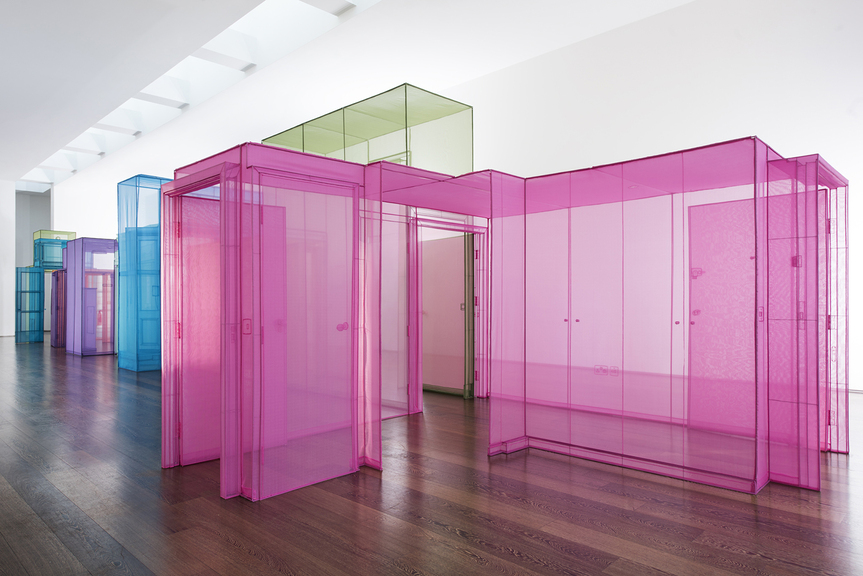Shows
Do Ho Suh’s “Passage/s”


In dreams, it is possible for places, events and conversations to coalesce under a singular logic. Their settings may have the appearance of one location and yet feel impalpably like another. In our reveries, the order of emotion and memory supersedes that of time and space, and the dreamer like the nostalgic finds herself in many places and none, subject to the detached wistfulness of liminality. By this standard, the pieces in Korean-born Do Ho Suh’s “Passage/s” at Victoria Miro gallery—the most extensive presentation of his work since a 2002 survey exhibition at the Serpentine Gallery—are his most dreamlike yet.

Whether with frottage, as in works from the “Rubbing/Loving Project” series (2012–16), or through architecturally precise fabric models, Suh has long sought to replicate and index his past homes. The contents of the exhibition’s first room were no exception, but employed a new process, and alluded to a fresh conceptual approach suggested in the title “Passage/s.” The pieces there were sewn in the same way as his recognizable fabric sculptures, but using gelatin tissue rather than polyester. The gelatin was then dissolved in water, compressing the form and leaving its tint and flattened lineation fused to paper in a depiction of space that eschews the axonometric projection of architectural drawings.
All but one of these works represented the facades of buildings and their entrances. The exception, Staircase, Ground Floor, 348 West 22nd Street, New York, NY 10011, USA (2016), offset them. This flattened coquelicot-red staircase, recalling the Tate-owned Staircase-III (2010), occupied more space in its implied three dimensions than the neighboring doorways, and hence would lose more of its form once flattened, heightening the effect of compression and suggesting the destabilizing experience of liminality.
The upstairs gallery was more focused on interior objects. One wall had basins and light bulbs subjected to the same gelatin technique, their subverted likenesses implying dream-creatures: medusal, elephantine, amoebal. Similar items appeared on the opposite side of the room as translucent polyester models. In between, skewed cyanotypes at once recalled blueprints and x-rays. Each group permitted otherwise impossible perspectives of familiar objects, as might a work of analytic cubism.

Next door, a three-channel video installation, Passage/s: The Pram Project (2014–16), projected footage from a GoPro mounted to the stroller of Suh’s daughter, cutting between excursions in Seoul and London, where he has lived since 2010. Here, Suh’s daughter dictates the logic by which space is ordered: she sings Korean songs in London and speaks English in Korea; she enquires about an upcoming trip to Seoul and suddenly we’re there; she provides the gaze through which we approach an Islington shopping center before the film cuts to the interior of its Korean analogue, hinting at a further compression of space as a function of global capital. The “/s” in the film’s title evokes an ambiguous plurality, the dreamlike possibility of being simultaneously in one and many places.
In the “Hubs” series (2015–16), exhibited in Gallery II, Suh’s signature fabric and wire structures made an appearance. However, unlike their forebears, they did not represent places defined by inhabitation, but liminal spaces: entranceways and corridors through which we are meant to pass but never truly be.

Replicated with precision after those in Suh’s various residences, these vividly colored, gossamer passages were conjoined in a walk-through configuration that traversed many implied places but arrived at none. Only the specificity of intricately detailed features—a door handle, light switch or fuse box—cut through the sense of constant transition with one of vicarious nostalgia. They were ghostly indices to someone else’s life, and yet familiar.
This is what makes Do Ho Suh’s art so appealing beyond its aesthetic and technical merit. His reflections on itinerancy are deeply personal, but hint at something shared. The loss of a home, even by choice, does not merely displace us in space. As time passes, we inexorably leave behind those places that have sheltered us, revisiting them only in dreams. In exposing the ceaseless in-betweens engendered by both our movements and by the passage of time, Suh’s work evokes and upholds a maxim: You can never go home again.
Do Ho Suh’s “Passage/s” is on view at Victoria Miro, London, until March 18, 2017.







